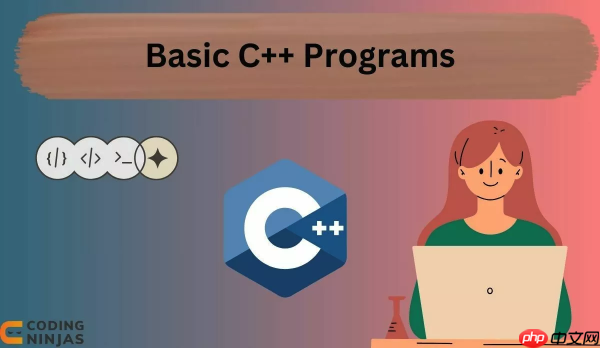结构化绑定通过auto [var1, var2, ...] = expression;语法,直接将复合类型(如pair、tuple、结构体、数组、map)的元素解包为具名变量,提升代码可读性与简洁性。它解决了传统访问方式(如.first、.second或std::get<N>())语义不清、冗长易错的问题,广泛应用于多返回值函数、map遍历、自定义结构体解构等场景。使用时需注意:绑定变量实质为元素的引用或别名,生命周期依赖原对象;应正确使用const、&等修饰符;自定义类型需满足聚合类型或提供tuple_size等特化支持;数组可用但指针不可用。C++17对右值临时对象有生命周期延长规则,但仍需警惕悬空引用风险。

C++17的结构化绑定(Structured Bindings)可以说是一个优雅的语法糖,它极大地简化了从复合类型(比如
std::pair
std::tuple
结构化绑定提供了一种直接将复合类型内部的元素“解包”到单独的具名变量中的方式。它不是创建新的对象副本,而更像是为现有对象内部的元素创建了别名或引用。
想象一下你有一个函数,它需要返回多个逻辑上相关的数据,比如一个操作是否成功以及如果成功返回的数据。在C++17之前,你可能会返回一个
std::pair
std::tuple
.first
.second
std::get<N>()
基本用法示例:
立即学习“C++免费学习笔记(深入)”;
#include <iostream>
#include <string>
#include <tuple>
#include <map>
// 示例1: 返回std::pair
std::pair<bool, std::string> fetchData(int id) {
if (id == 1) {
return {true, &quot;Data for ID 1&quot;};
}
return {false, &quot;No data found&quot;};
}
// 示例2: 返回std::tuple
std::tuple<int, double, std::string> processRecord() {
return {100, 3.14, &quot;Processed successfully&quot;};
}
// 示例3: 自定义结构体
struct UserInfo {
int id;
std::string name;
double score;
};
UserInfo getUser(int userId) {
return {userId, &quot;Alice&quot;, 95.5};
}
int main() {
// 解包std::pair
auto [success, message] = fetchData(1);
if (success) {
std::cout << &quot;Fetch success: &quot; << message << std::endl;
} else {
std::cout << &quot;Fetch failed: &quot; << message << std::endl;
}
// 解包std::tuple
auto [code, value, status] = processRecord();
std::cout << &quot;Process result: Code=&quot; << code << &quot;, Value=&quot; << value << &quot;, Status=&quot; << status << std::endl;
// 解包自定义结构体
auto [userId, userName, userScore] = getUser(123);
std::cout << &quot;User: ID=&quot; << userId << &quot;, Name=&quot; << userName << &quot;, Score=&quot; << userScore << std::endl;
// 遍历std::map
std::map<std::string, int> ages = {{&quot;Alice&quot;, 30}, {&quot;Bob&quot;, 25}};
for (const auto&amp; [name, age] : ages) {
std::cout << name << &quot; is &quot; << age << &quot; years old.&quot; << std::endl;
}
// 解包数组 (虽然不常见,但可以)
int arr[] = {10, 20, 30};
auto [a, b, c] = arr;
std::cout << &quot;Array elements: &quot; << a << &quot;, &quot; << b << &quot;, &quot; << c << std::endl;
return 0;
}通过
auto [var1, var2, ...] = expression;
expression
在我看来,结构化绑定之所以被引入C++17,核心原因就是为了解决代码冗余和可读性差的问题。在它出现之前,处理多返回值或者从复杂数据结构中提取特定部分,确实有点让人头疼。
具体来说,它解决了以下几个痛点:
你可能遇到过这样的场景:一个函数返回
std::pair<Iterator, bool>
std::map
std::pair<std::map<int, std::string>::iterator, bool> result = myMap.insert({1, &quot;One&quot;});
if (result.second) {
std::cout << &quot;Inserted: &quot; << result.first->second << std::endl;
}说实话,
result.first
result.second
auto [it, inserted] = myMap.insert({1, &quot;One&quot;});
if (inserted) {
std::cout << &quot;Inserted: &quot; << it->second << std::endl;
}这简直是天壤之别,
it
inserted
再比如,当函数返回
std::tuple
std::get<0>()
std::get<1>()
std::get<2>()
所以,结构化绑定本质上是把那些需要“解构”复杂类型并单独使用其内部元素的场景,变得更加流畅和自然。它减少了样板代码,提升了代码的表达力,让开发者可以更专注于业务逻辑,而不是如何从容器中取出数据。我个人觉得,这是C++现代化过程中一个非常成功的改进,它让C++在某些方面写起来更像Python这样的脚本语言,但又保留了C++的性能优势。
结构化绑定在实际项目中的应用非常广泛,只要涉及到从一个复合类型中提取多个逻辑上独立的“值”,它就能派上用场。我这里列举几个常见的场景,你肯定会在日常开发中遇到:
处理函数的多返回值: 这是最直接也最常用的场景。
std::pair<bool, std::string>
bool
std::string
auto [success, messageOrId] = dbClient.insertUser(user);
if (!success) { /* handle error */ }std::tuple<ParseStatus, ParsedData, ErrorCode>
auto [status, data, err] = parseConfigFile(&quot;config.json&quot;);
if (status == ParseStatus::OK) { /* use data */ }std::map
std::unordered_map
std::pair<const Key, Value>
std::map<std::string, int> scores = {{&quot;Alice&quot;, 90}, {&quot;Bob&quot;, 85}};
for (const auto&amp; [name, score] : scores) { // 注意const auto&amp;
std::cout << name << &quot;: &quot; << score << std::endl;
}
// 插入操作,判断是否成功
auto [iter, inserted] = scores.insert({&quot;Charlie&quot;, 92});
if (inserted) {
std::cout << &quot;Charlie added with score: &quot; << iter->second << std::endl;
}自定义结构体作为返回值或参数: 当你定义了一个简单的POD(Plain Old Data)结构体,用来封装一组相关的数据时,结构化绑定可以方便地解构它。
struct Point { int x, y; };
Point getOrigin() { return {0, 0}; }
auto [ox, oy] = getOrigin();
std::cout << &quot;Origin: (&quot; << ox << &quot;, &quot; << oy << &quot;)&quot; << std::endl;这比写
Point p = getOrigin(); int ox = p.x; int oy = p.y;
结合std::optional
std::variant
optional
variant
Result<T, E>
Result
std::variant<T, E>
Result
这些场景都体现了结构化绑定在提升代码可读性和编写效率方面的巨大价值。它让处理聚合数据变得更加自然,就像这些数据天生就是分开的一样。
虽然结构化绑定非常方便,但在使用过程中,还是有一些细节和潜在的“坑”需要我们留意。了解这些能帮助我们写出更健壮、更正确的代码。
生命周期管理: 这是最需要注意的一点。结构化绑定创建的变量,并不是原始对象的副本,而是对原始对象内部元素的“引用”或“别名”。这意味着它们的生命周期与原始对象紧密相关。如果原始对象是临时变量,并且在结构化绑定表达式结束后就被销毁了,那么你绑定的变量就变成了悬空引用(dangling reference),访问它们会导致未定义行为。
#include <iostream>
#include <string>
#include <utility> // For std::pair
std::pair<int, std::string> createTempPair() {
return {1, &quot;Hello&quot;};
}
int main() {
// 错误示例:tempPair在分号处销毁,id和msg变成悬空引用
// auto [id, msg] = createTempPair(); // 编译器可能会警告或报错,取决于C++版本和编译器
// std::cout << id << &quot;: &quot; << msg << std::endl; // 未定义行为
// 正确做法:将临时对象绑定到const引用,延长其生命周期
const auto&amp; tempPair = createTempPair();
auto [id, msg] = tempPair; // id和msg现在是tempPair的副本,或者引用,但tempPair生命周期被延长
std::cout << id << &quot;: &quot; << msg << std::endl;
// 或者直接让结构化绑定变量成为副本(如果原始对象是右值)
// auto [id2, msg2] = createTempPair(); // C++17标准规定,如果绑定的是纯右值,会延长其生命周期
// std::cout << id2 << &quot;: &quot; << msg2 << std::endl; // 这样是安全的!
// 澄清:对于`auto [id, msg] = createTempPair();` 这种形式,
// C++17标准确实规定了临时对象的生命周期会延长到结构化绑定变量的生命周期结束。
// 但如果你的复合类型内部包含的是引用,那还是得小心原始被引用对象的生命周期。
// 总之,理解它不是副本,而是引用或别名,是关键。
return 0;
}尽管C++17标准对右值绑定有生命周期延长规则,但养成习惯,清楚绑定的是引用还是副本,总归是好的。对于复杂场景,明确原始对象的生命周期非常重要。
const
&
const
&
&&
auto [a, b] = obj;
a
b
obj
auto& [a, b] = obj;
a
b
obj
a
b
obj
const auto& [a, b] = obj;
a
b
obj
const
obj
auto&& [a, b] = obj;
a
b
obj
选择正确的修饰符,取决于你是想复制值、引用值还是移动值,以及是否需要修改原对象。
不是真正的解构,而是绑定: 结构化绑定并没有“解构”原始对象,它只是为原始对象中的特定元素创建了新的具名变量。这意味着原始对象仍然存在,并且其状态可以通过其他方式访问和修改。
对自定义类型的要求: 如果你想对自定义的类或结构体使用结构化绑定,该类型需要满足一些特定条件:
std::tuple_size
std::tuple_element
get<N>()
std::tuple
数组的限制: 结构化绑定可以用于C风格数组,但不能用于指针。
int arr[] = {1, 2, 3}; auto [a, b, c] = arr;int* ptr = new int[3]; auto [a, b, c] = ptr;
理解这些细节,特别是生命周期和引用修饰符的影响,能让你更自信、更安全地使用结构化绑定,避免一些隐蔽的运行时错误。它是个强大的工具,但就像所有强大的工具一样,也需要正确的使用姿势。
以上就是C++17结构化绑定 多返回值解包技巧的详细内容,更多请关注php中文网其它相关文章!

每个人都需要一台速度更快、更稳定的 PC。随着时间的推移,垃圾文件、旧注册表数据和不必要的后台进程会占用资源并降低性能。幸运的是,许多工具可以让 Windows 保持平稳运行。

Copyright 2014-2025 https://www.php.cn/ All Rights Reserved | php.cn | 湘ICP备2023035733号